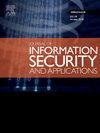改进的生物特征数据保护:最大似然解码的有限蛮力策略
IF 3.7
2区 计算机科学
Q2 COMPUTER SCIENCE, INFORMATION SYSTEMS
Journal of Information Security and Applications
Pub Date : 2025-08-16
DOI:10.1016/j.jisa.2025.104182
引用次数: 0
摘要
传统的生物特征数据保护方案在转换后往往难以提供强大可靠的安全保障,这主要是由于量化过程中引入的噪声放大。这种放大的噪声会扭曲受保护的生物特征数据和原始生物特征数据之间的关系,在受保护表示的声称安全性和原始输入的实际安全性之间造成差距。这种不匹配可能会高估系统的健壮性,并可能使方案暴露于诸如预映像攻击之类的漏洞。为了解决这一挑战,我们提出了一种新的安全草图结构,该结构将位置敏感哈希(LSH)与最大似然解码的有界蛮力策略集成在一起。我们的方法实现了渐近最优的容错性,同时保留了跨未保护和受保护域的类间和类内可变性的统计一致性。这种对齐可以实现准确的密钥恢复,并增强对预图像和解码攻击的抵抗力。综合实验表明,我们的方法在安全性和对生物特征可变性的鲁棒性方面始终优于现有方法,为生物特征认证提供了实用和理论基础的解决方案。本文章由计算机程序翻译,如有差异,请以英文原文为准。
Improved biometric data protection: Bounded brute-force strategy for maximum likelihood decoding
Conventional biometric data protection schemes often struggle to provide strong and reliable security guarantees after transformation, largely due to the noise amplification introduced during quantization. This amplified noise can distort the relationship between the protected and original biometric data, creating a gap between the claimed security of the protected representation and the actual security of the raw input. Such a mismatch risks overestimating system robustness and may expose the scheme to vulnerabilities such as pre-image attacks. To address this challenge, we propose a novel secure sketch construction that integrates Locality-Sensitive Hashing (LSH) with a bounded brute-force strategy for maximum likelihood decoding. Our method achieves asymptotically optimal error tolerance while preserving the statistical alignment of inter- and intra-class variability across both unprotected and protected domains. This alignment enables accurate key recovery and enhances resistance to pre-image and decoding attacks. Comprehensive experiments demonstrate that our method consistently outperforms existing approaches in both security and robustness to biometric variability, offering a practical and theoretically grounded solution for biometric authentication.
求助全文
通过发布文献求助,成功后即可免费获取论文全文。
去求助
来源期刊

Journal of Information Security and Applications
Computer Science-Computer Networks and Communications
CiteScore
10.90
自引率
5.40%
发文量
206
审稿时长
56 days
期刊介绍:
Journal of Information Security and Applications (JISA) focuses on the original research and practice-driven applications with relevance to information security and applications. JISA provides a common linkage between a vibrant scientific and research community and industry professionals by offering a clear view on modern problems and challenges in information security, as well as identifying promising scientific and "best-practice" solutions. JISA issues offer a balance between original research work and innovative industrial approaches by internationally renowned information security experts and researchers.
 求助内容:
求助内容: 应助结果提醒方式:
应助结果提醒方式:


